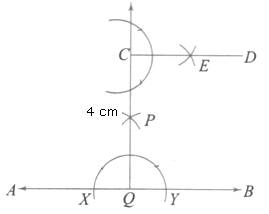CBSE Class 7 Answered
Draw a line AB and then construct another line parallel to AB which is 4 cm above it.
Asked by Topperlearning User | 04 Jun, 2014, 01:23: PM

Steps of constructions:
1. Draw a line AB, take any point Q on it.
2. Taking Q as a center draw an arc XY.
3. Taking same radius draw two arcs from X and Y and let them intersect at P.
4. Join QP and extend.
5. On QP, take a point C such that QC = 4 cm.
6. Again from C, draw a perpendicular line CD.
7. Hence CD is parallel to AB.
Answered by | 04 Jun, 2014, 03:23: PM
Concept Videos
CBSE 7 - Maths
Asked by upadhyaynituashu | 05 Nov, 2023, 08:26: PM
CBSE 7 - Maths
Asked by indradevi0306 | 10 Jan, 2021, 02:54: PM
CBSE 7 - Maths
Asked by Topperlearning User | 14 Oct, 2014, 01:09: PM
CBSE 7 - Maths
Asked by Topperlearning User | 29 Nov, 2013, 07:21: AM
CBSE 7 - Maths
Asked by Topperlearning User | 04 Jun, 2014, 01:23: PM
CBSE 7 - Maths
Asked by Topperlearning User | 04 Jun, 2014, 01:23: PM
CBSE 7 - Maths
Asked by Topperlearning User | 14 Oct, 2014, 01:09: PM
CBSE 7 - Maths
Asked by Topperlearning User | 04 Jun, 2014, 01:23: PM
CBSE 7 - Maths
Asked by Topperlearning User | 07 Jan, 2015, 02:38: PM
CBSE 7 - Maths
Asked by Topperlearning User | 04 Jun, 2014, 01:23: PM


